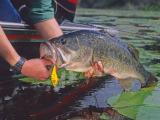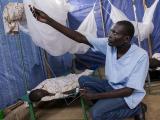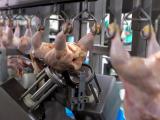Jun 10, 2005 (CIDRAP News) The US Department of Agriculture (USDA) and several beef industry officials at a St. Paul meeting yesterday made the case for resuming importation of live Canadian cattle, which have been banned since Canada's first case of bovine spongiform encephalopathy (BSE) turned up in May 2003.
In a roundtable discussion that packed an auditorium at the University of Minnesota, officials asserted that it's safe to reopen the border because both countries have strong and essentially identical "firewalls" for preventing BSE. They also warned that the border closure is hurting US meat processors and could ultimately strengthen Canada's beef exports at the expense of the United States.
"I'm confident that the beef supply in North America is a safe beef supply," USDA Secretary Mike Johanns declared in his opening remarks.
Two cattle-producer groups, R-CALF United Stockgrowers of America (R-CALF USA) and the National Farmers Union, declined to join the call to end the import ban. An R-CALF spokesman contended that US and Canadian safeguards are inadequate and that the three BSE cases in Canada show the feed restrictions there have not worked.
The USDA had proposed to reopen the border to live Canadian cattle younger than 30 months of age on Mar 7 of this year, after classifying Canada as a "minimal risk region" for BSE. (The United States resumed importation of boneless Canadian beef in late 2003.) But on Mar 2, a federal judge in Montana ordered the agency to delay the move on grounds that it could increase human exposure to BSE. The ruling came in a lawsuit filed by R-CALF USA.
The Ninth US Circuit Court of Appeals is scheduled to rule Jul 13 on a challenge to the injunction that blocked the border reopening, according to a report today in the Minneapolis Star Tribune.
In response to the first US case of BSE, discovered in a Canadian-born cow in December 2003, the USDA greatly expanded its BSE testing program. Johanns said at the meeting, "Our surveillance program has now tested about 375,000 cattle in the high-risk populations, and we haven't found any cases of BSE." The testing program has focused on cattle unable to walk or showing signs of neurologic disease.
Cattle contract BSE by eating feed containing protein from infected cattle. Ron DeHaven, administrator of the USDA's Animal and Plant Health Inspection Service, explained that the United States and Canada imposed similar bans in 1997 on the use of ruminant protein in feed for ruminants. He added that both countries have successful BSE testing programs.
USDA experts have reviewed and endorsed Canada's feed-ban enforcement program, its epidemiologic investigations of BSE cases, and its compliance with international guidelines for preventing BSE, DeHaven said. "USDA is fully confident that American and Canadian cattle are both equally protected from BSE," he added.
Barbara Masters, acting administrator of the USDA's Food Safety and Inspection Service, reviewed the BSE safeguards added after the first US case was found. The main ones were the holding of cattle carcasses tested for BSE until test results are in and the ban on "specified risk materials" (SRM), high-risk tissues such as the brain and spinal cord, from the human food chain.
In brief, time-limited comments, representatives of several beef industry groups supported the USDA plan to reopen the border. All the panel members were there at the USDA's invitation.
Kelli Ludlum of the American Farm Bureau Federation said her group strongly supports the USDA plan. Calling the risk of BSE to the US food supply "minuscule," she said, "There is no scientific justification for keeping the Canadian border closed."
Carl Kuehne of the American Meat Institute contrasted the North American and European experiences with BSE. More than 180,000 BSE cases have occurred worldwide, most of them in the United Kingdom, as compared with three in Canada and one in the United States, he said. The world has had 158 cases of variant Creutzfeldt-Jakob disease (vCJD), the human equivalent of BSE, but none have occurred in American or Canadian citizens, he added.
"Clearly, North America is not Europe," Kuehne said.
Mike Johns of the National Cattleman's Beef Association and John Adams of the National Milk Producers Federation also expressed support for reopening the border.
"The multiple-firewall approach is working," said Johns.
But Bill Bullard, a spokesman for R-CALF USA, disagreed. He called the US BSE safeguards "inadequate" in comparison with those of many other countries. The US feed ban is the same as one imposed in the United Kingdom in 1988, which failed to stop the spread of BSE there, he said. He also said the United States has yet to follow the recommendation of experts to ban the use of cattle blood and poultry litter in cattle feed.
Bullard called for more BSE testing to verify the effectiveness of the existing measures. He further suggested that BSE risks are not equal in Canada and the United States. "With far fewer tests70,000they've found multiple cases of BSE," which shows that the feed ban failed to prevent spread of the disease, he said.
In addition, Bullard said that Canada has not met international standards recommended for preventing the spread of BSE because it has not banned SRM from all animal feed. (Neither Canada nor the United States has banned SRM from feed for nonruminant animals. Such a ban would prevent cross-contamination, whereby SRM in cattle parts used in feed for pigs, poultry, or pets could end up in cattle feed if both kinds of feed are made with the same equipment or in the same plant. Cross-contamination also can occur if cattle are given feed intended for other animals.)
Dennis Sjodin, a spokesman for the National Farmers Union, also opposed an immediate reopening of the border. He said the latest Canadian BSE case was in a cow born after the feed ban took effect. "We believe the [border closure] issue must be resolved as soon as possible, but that doesn't mean taking unnecessary risks for the industry and consumers," he said.
In responding to Bullard, APHIS's DeHaven said Canada has tested a higher proportion of its high-risk cattle population than the United States has, given that Canada has about 5.5 million adult cattle and the Untied States has about 45 million.
DeHaven also called the US and Canadian feed bans "very, very similar." One difference, however, is that the United States allows restaurant plate waste and poultry litter to be used in ruminant feed, whereas Canada does not, he said.
An official of the National Renderers Association, David Kaluzny II, responded to Bullard's point about the failure of the original UK feed ban to prevent BSE from spreading. He said enforcement of the British feed ban in the early years was "very loose," which allowed the disease to spread to other countries. "We shouldn't be comparing ourselves to their experience," he said. "The [US] ban has worked."
More than one panelist contended that the US ban on Canadian cattle imports is inconsistent with its demand that Japan resume importation of American beef. Japan and many other countries stopped importing US beef when the US BSE was discovered.
"We need to be consistent. The only way to do that is to open up to Canada on the same terms and conditions that we're asking from Japan and others," said Kuehne of the American Meat Institute.
The panelists also talked a lot about the effect of the border closure on the structure of the beef industry, especially on meat packers and processors. Several warned that the closure is restricting the flow of cattle to US slaughter plants, forcing some to lay off workers or even shut down.
Johanns, in his opening remarks, said, "Every day that the border is closed there's an impact. The very large processors do find ways to surviveit's the small ones that suffer." He reported that a meatpacking plant in Nebraska had just shut down, eliminating 200 jobs.
Keith Collins, the USDA's chief economist, discussed the effects of the border closure on US and Canadian beef trade and prices. With the US border open to Canadian beef but closed to live cattle and with Canadian beef prices way down, Canadian slaughter plants expanded their capacity by about 25% in 2004 and are continuing to expand this year, he said. Meanwhile, cattle slaughtering in the United States dropped about 8% in 2004.
"The longer the border remains closed, the more likely Canada will continue to expand cattle slaughter and beef exports to the United States, and ultimately to the rest of the world," Collins said.
He warned that without access to Canadian cattle, American slaughter plants will continue to operate below capacity, forcing some to cut back their operations, even though high beef prices are likely to trigger increased US cattle production. As US slaughterhouses shut down, US cattle producers have fewer places to sell their cattle, Collin said.
See also:
Mar 4, 2005, CIDRAP News story "BSE-related ruling prolongs US ban on Canadian cattle"


















